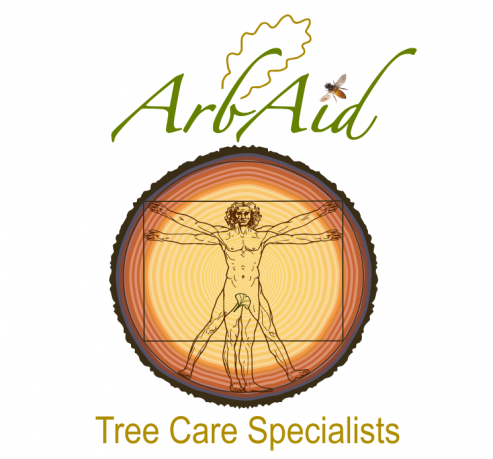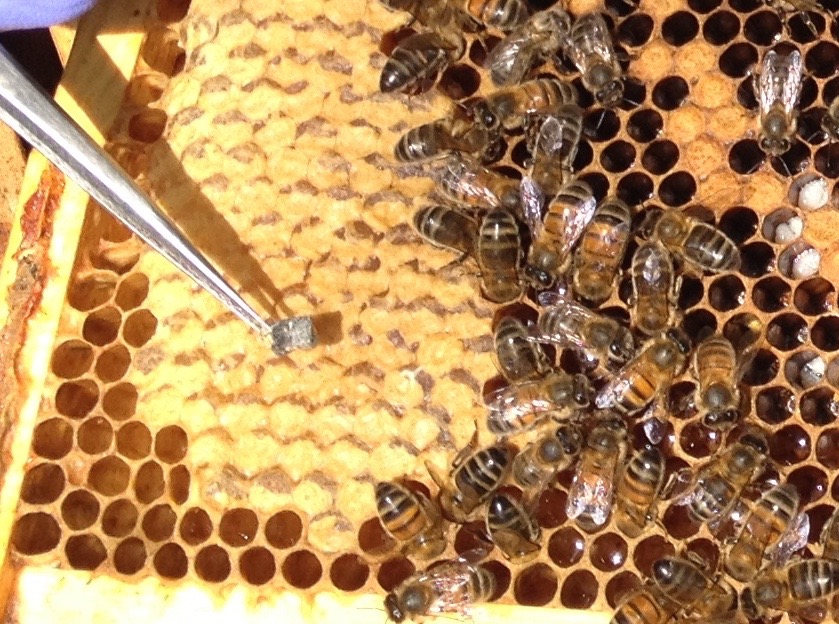Late May and a fellow Bee keeper’s apiary is being inspected by the National Bee Unit (NBU< Animal & plant health agency) for American foul brood (AFB) and European foul brood (EFB), see below for info. Thank you to Dr Roger Burns for inviting me to his apiary in Pembrokeshire to learn more about Bee disease’s. A Tree Surgeon has a vast knowledge of disorders from trees to insects and from the air to the soil, which I’d like to share so you can be able to notice and help prevent failure in our loved and respected landscape. At the bottom of the post are details of AFB and EFB as well as the issues that were found within the hives
Cleaning hive tools is vital to prevent contamination spreading, here Rachel (NBU) uses 10% domestic bleach (90% tap water) to remove bacteria before inspection begins.
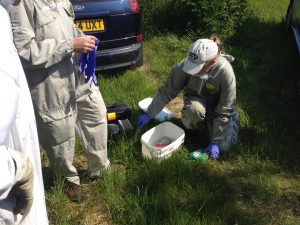
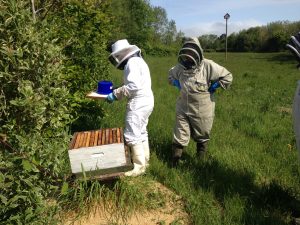
A cell has a broken seal and the inspector is removing its contents to be examined.
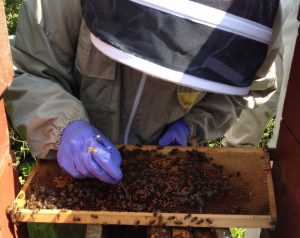
The contents are placed inside a plastic beaker with a ball bearing inside.
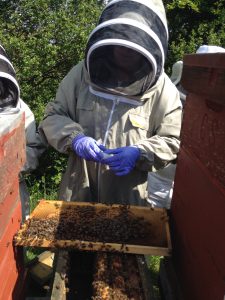
The contents are then pulverised with a right hand shake.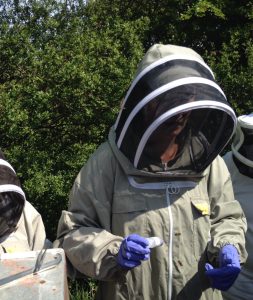
The pulverised cell is left for a minute to settle. Beside the beaker is the test kit, a bit like a pregnancy test kit but without the life long trauma
.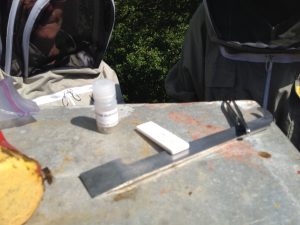
A pipette then withdraws the contents of the beaker and places it in a dip on the test vessel. After 1 minute the blue lines tell if there is either AFB or EFB, two blue lines and the hives will be destroyed, 1 blue line and honey is on the toast.
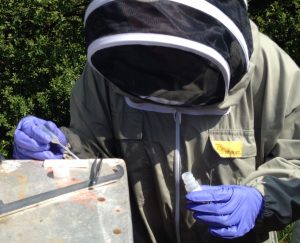
The white small chalk like pieces are brood/pupae that have been infected with Chalk brood (CB) whilst developing in the cell. CB is a fungal infection that kills the pupae.
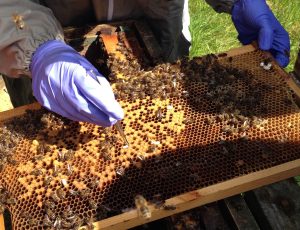
The super is removed so the brood body of the hive can be inspected.
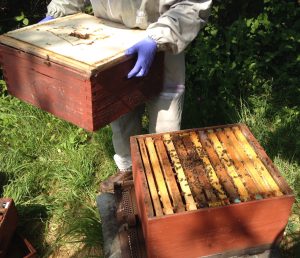
The nursery bees are mainly in the centre caring for the pupae and newly emerged ladies.
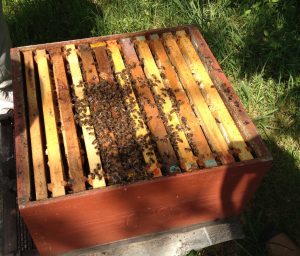
This is a classic form of the frame of brood, the centre main structure of the frame is eggs, pupae (open cell) and the closed dark orange/brown are the sealed cells as the pupae metamorphosis to bees prior to hatching. To the outside of the frame is more yellow like capping of the cells, this is honey and pollen stored directly to feed newly emerged bees.
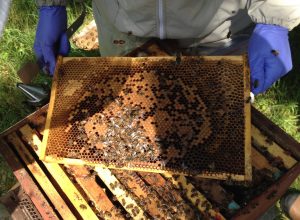
This is pupae that has been infected with Sacbrood (SB). See below for SB info.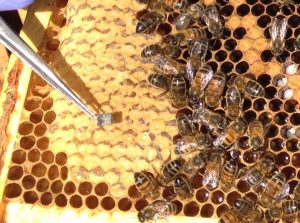
CB is spotted and removed, see tweezer in top of photo. Also, the frame form with the brood in the centre and stores of honey to outside. See below for CB info.

Honey is taken from the super frames, to be analysed for Foulbrood.
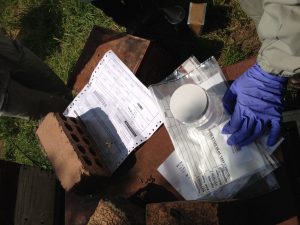
Three scoops are placed in a jar.
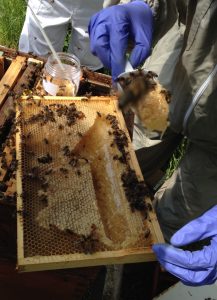
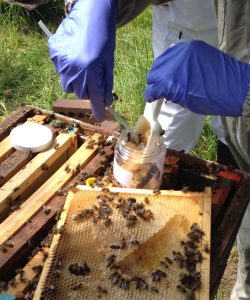
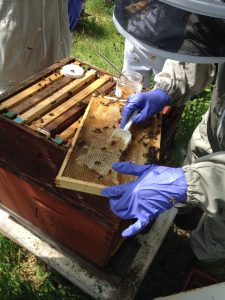
60+ Stings to the left of my bee suit vale and 5 stings to my shoulders (I only had a vest on my top half). After inspecting ten hives in four hours the bees got quite angry. There must have been some pheramone on my vale as the stings were localised to that area.
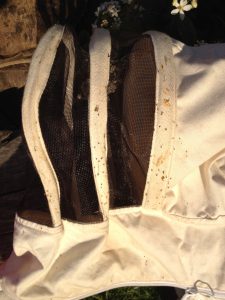
Thank you for looking at Arb-Aid’s Apiary, Back Garden Beekeeping by a Pembrokeshire Tree Surgeon.
American Foulbrood and European Foulbrood
AFB is caused by spore forming bacterium called Paenibacillus larvae. Spores are the infective stage of the disease and infection begins when food contaminated with spores are fed to larvae by the nurse bees.
The characteristic disease signs :
- Uneven or ‘Pepper-pot’ brood pattern;
- Sunken, greasy or perforated, darkened cell cappings;
- Roping, sticky larval remains when drawn out with a matchstick;
- Dark “scales”, which are difficult to remove from cells.
EFB is caused by the bacterium Melissococcus plutonius. Larvae become infected by consuming contaminated food fed by the nurse bees.
An infected colony may show signs :
- Erratic or uneven brood pattern;
- Twisted larvae with creamy-white guts visible through the body wall;
- Melted down, yellowy white larvae;
- An unpleasant sour odour;
- Loosely-attached brown scales;
- Unlike AFB, the remains of larvae that die from EFB do not rope when drawn out with a matchstick.
Control of AFB
All infected colonies are destroyed. The first stage is to kill the adult bees by tipping a bit of petrol through the crown board. All combs and any zinc queen excluders from the colony(ies) are then destroyed by burning them in a pit. The rest of the hive(s) and any appliances are sterilised by scorching with a blow lamp or sterilising with appropriate chemicals.
Control of EFB
There are three options available to the beekeeper who has colonies infected :
1. The colonies can be treated with the shook swarm husbandry method. See NBU website.
2. The colonies may be treated with the antibiotic oxytetracycline.
3. The colonies may be destroyed, as for AFB. This will be carried out if the colony is too small for other treatment methods, is too heavily infected to respond to treatment, or at the beekeepers request.
However, the range of options available will also depend upon the time of year that the disease is diagnosed and other factors such as the strength of the colony or the level of infection.
Chalkbrood
Chalkbrood is caused by the fungus Ascosphaera apis which is ingested by the larvae where it then penetrates the gut wall to absorb nutrients. As the spores germinate and multiply, the larva eventualy dies of starvation. After a few days of growth, the larva and fungus swells and fills the brood cell where it will eventually harden after a few days to it’s distinctive ‘mummyfied’ appearance. Here it adopts a mottled white and black colour and each chalkbrood mummy will produce millions of infective spores which stick to the cells, hive components and adult bees.
Symptoms
Start to appear in early spring as the colony starts to build up its population. Conditions such asdamp and cold weather will promote fungal spores. Typical symptoms of chalkbrood will include:
- Initially the dead larvae will be covered with a white cotton wool-like growth and may swell to fill the cell taking on its shape;
- After a time these will dry out and shrink to give the characteristic ‘mummies’ that are chalk-like at first turning to a greyish black colour as the fungal fruiting bodies develop;
- Worker bees uncap the cells of dead larvae so the mummies will be clearly visible;
- shrunken chalk-like mummies in the brood and in and around the hive entrance.
- As the condition worsens, iunfected hives will also show a pepper pot brood pattern;
- If mummies are still contained in capped cells, when a comb is shaken gently the mummies may be heard rattling in the cells.
Spread
A. apis is highly infectious and can be easily spread between hives throughrobbing and drifting of drones and worker bees. Spores can be transferred between apiaries on contaminated equipment and through the intervention of the beekeeper.
Treatment
Not a serious disease among strong healthy colonies. However, insmaller colonies or those under stress (for example suffering heavy varroa infestations) it can become a problem. For keeping chalkbrood to a minimum the maintenance of good strong stocks which appear better able to resist the fungus. Hives which are suceptable can be re-queened.
Sacbrood
A viral infection of the brood caused by Iflavirus genus and occurs when a diseased larva fails to pupate after they have been sealed in its cell. Fluid then accumulates between the body of the larva and the unshed skin, forming a sac. A relatively common disease during the first half of the brood-rearing season and can often exist unnoticed affecting only a small percentage of the brood and does not usually cause severe colony loss.
Symptoms
The virus particles replicate in the developing larva, which appear to develop normally until after being capped over. Typical symptoms include:
- The infected larva then turns from it’s usual pearly white to a pale yellow colour;
- The larva will eventually die and begin to dry out, turning a dark brown to black colour, giving rise to the characteristic ‘Chinese slippers’ or ‘gondola-shaped’ scales;
- As the larvae die, the workers will uncap the cells to expose them, creating an uneven brood pattern with discoloured, sunken or perforated cappings scattered through the brood cells;
- The skin of the dead larva also changes into a tough plastic-like sac, which is filled with fluid. It is this stage of infection that gives the virus its name. The sac can be carefully removed by using a pair of tweezers.
Spread
Can spread through the intervention of the beekeeping through the use of infected equipment and by transferring material from infected colonies to a healthy colony. In addition, the virus can spread through the feeding behaviour of nurse bees and bees robbing infected colonies.
Treatment
Re-queening the colony can help to aleviate the symptoms of sacbrood.
